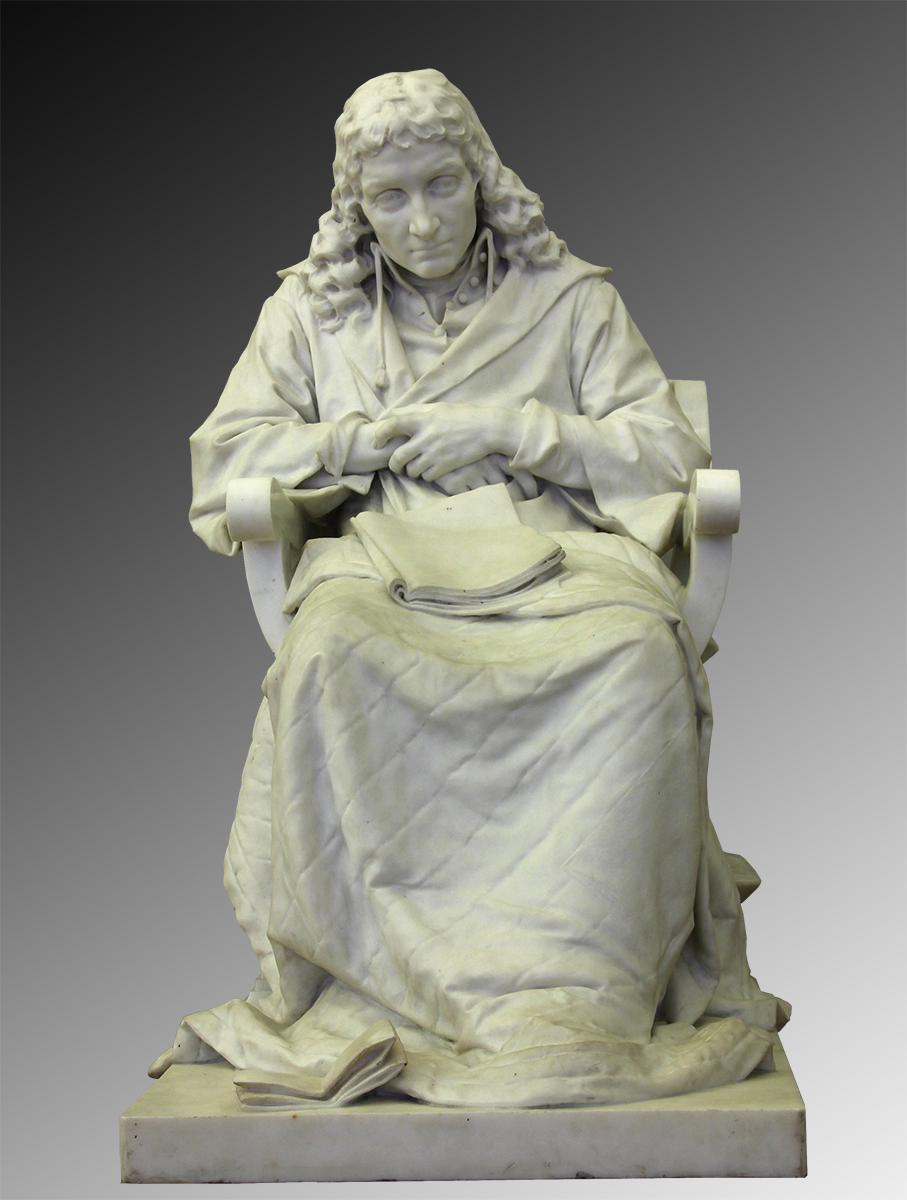


Образ великого голландского философа Бенедикта Спинозы, подвергшего сокрушительной критике социальную несправедливость, противника монархии и сторонника республики, автора "Этики", изгнанного за безбожие из синагоги, от которой он отрекся, возник у Антокольского в Италии почти одновременно с образом Христа. И это не случайно: в жизни и деятельности Спинозы скульптор также увидел пример подвижничества и самопожертвования. Великий философ изображен сидящим в кресле. Больной, физически немощный человек погружен в свои думы. Точно найдена поза и жест сложенных у груди тонких, худых рук. Скульптор подчеркивает скромность, спокойствие и, одновременно, силу и величие ума модели. Сознание своей правоты и вместе с тем скорбная покорность судьбе ощущаются в выражении задумчивого одухотворенного лица, в легкой, чуть тронувшей губы, улыбке. Скульптор считал эту статую значительно выше своих прежних работ по технике исполнения.
Спиноза Бенедикт (Spinoza, Benedictus) (1632–1677), или Барух д'Эспиноза, великий голландский философ, один из крупнейших рационалистов XVII века.
Скульптор.
Обучался в Императорской Академии художеств в качестве вольнослушателя у Н. С. Пименова и И. И. Реймерса (1862-1870). В 1871 получил звание академика за статую «Иван Грозный» (гипс, Кенсингтонский музей, Лондон). Жил в Италии (1871-1877) и Франции (1877-1902), ежегодно приезжая в Россию. На Всемирной выставке в Париже был награжден золотой медалью и орденом Почетного легиона (1878). С 1880 – профессор, с 1893 – действительный член Императорской Академии художеств, а также почетный член Парижской, Берлинской и Урбинской Академий художеств. Среди наиболее известных произведений, хранящихся в Русском музее – статуи «Иван Грозный» (1871, бронза), «Христос перед судом народа» (1878, бронза), «Спиноза» (1882, мрамор), «Мефистофель» (1883, мрамор), «Ермак» (1891, бронза); портреты С.П. Боткина (1874, мрамор), И. С. Тургенева (1880, гипс), императрицы Марии Федоровны (1887, мрамор), императора Николая II и императрицы Александры Федоровны (оба – 1896, мрамор). Созданные по его моделям монументы Петру I были установлены в Петергофе, Петербурге, Таганроге, Архангельске.

This sculpture depicts Benedict de Spinoza, who formulated a tremendous criticism of the social injustice, was an opponent to the monarchy and a supporter of the republic, the author of "Ethics", and was expelled for godlessness from the synagogue, from which he renounced his faith. The idea of representation of Spinoza came to Antokolsky in Italy almost simultaneously with the idea of creating the image of Christ.
This is not a coincidence as Antokolsky saw in the life and activity of Spinoza an example of devotion and self-abnegation. This statue represents the great philosopher sitting on an armchair. As Spinoza was sick and infirm, he was absorbed in his thoughts. In this sculpture, his pensive attitude and heavy movements with his slender and lean hands resting on his chest depict his condition. The sculptor underlined Spinoza’s modesty and composure, as well as his strength and elevation of mind. The consciousness of his rightness and, at the same time, his sorrowful submission to his fate is palpable thanks to the meditative expression on his exalted face and his faint smile depicted by his twisted lips. The sculptor considered that this statue was significantly better than his previous works in terms of artistic technique.
Benedicto de Spinoza (Benedict de Spinoza) (1632–1677), or Baruch Spinoza, was an eminent Dutch philosopher, one of the great rationalists of the 17th century.
The sculptor Mark Antokolsky moved to St Petersburg in 1862, where he studied under Nikolai Pimenov and Johann Reymers at the Imperial Academy of Arts. In 1871 he started work on his sculpture of Ivan the Terrible (plaster, Kensington Museum, London). During the early 1870s he lived in Italy, before moving to France in 1877, although he visited Russia every year. Antokolsky was awarded a gold medal and Légion d’honneur at the Exposition Universelle, Paris in 1878 and was later made a professor, then full member of the Imperial Academy of Arts, where he held solo exhibitions in 1880 and 1893. He was also an honorary member of Académie des Beaux-Arts in Paris, Akademie der Künste in Berlin and Accademia di Belle Arti in Urbino.



